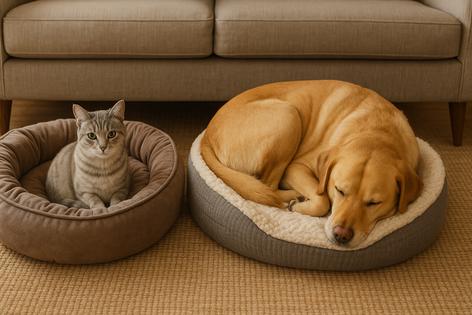How to choose the right pet bed -- comfort, support and practicality in one place
Published in Cats & Dogs News
A pet bed is more than a soft place to nap. For many dogs and cats, it serves as a refuge — a space that smells right, fits right and offers the quiet stability they don’t always find in the bustle of a human household. Yet the market is flooded with options, from orthopedic memory foam to raised cots to cave-style hideaways. Picking the right bed can feel surprisingly complicated. Experts say the decision requires a mix of careful observation, a bit of trial and error and a solid understanding of what your pet needs at different stages of life.
Size Matters — But Not Always the Way People Expect
The most common mistake owners make is choosing a bed that’s too small. Pets, especially dogs, rarely sleep curled up all night. Many stretch out fully at some point, which means they need room for long legs, splayed paws and shifting positions. A bed that’s too tight can cause pressure on joints and limit circulation.
Still, a cavernous bed isn’t always ideal. Cats, small dogs and anxious pets often prefer snugger spaces where walls or bolsters create a sense of enclosure. Oversized beds can make them feel exposed rather than comforted. Observing your pet’s natural sleeping posture — sprawled, curled, leaning or burrowed — is the clearest guide.
For large breeds, experts recommend measuring nose-to-tail while the dog is fully stretched. That number, plus several extra inches, dictates the minimum usable length. Cats tend to do well with multiple resting spots: one open, one enclosed, and one elevated.
The Importance of Materials and Support
A bed’s filling matters far more than its shape or color. Low-quality stuffing quickly compresses, leaving pets essentially lying on the floor. Memory foam — especially high-density varieties — provides consistent support for dogs with arthritis, hip dysplasia or recovering injuries. It distributes weight evenly and reduces pressure points, making it a go-to choice for senior animals.
Polyfill beds, while softer at first, lose loft quickly. They can still be appropriate for young, healthy pets who like a plush nest but are less ideal for older animals. Gel-infused memory foam offers temperature regulation for pets who overheat, while orthopedic egg-crate foam is a budget-friendly option that still offers useful support.
Owners should press down on a potential bed in the store or read reviews closely online. If your hand sinks to the bottom easily, your pet’s elbows and hips probably will too.
Choosing the Right Shape for Your Pet’s Sleep Style
Bolster beds — those with raised sides — appeal to dogs who like resting their heads on something or prefer enclosed comfort. They give a sense of boundary, which can soothe anxious pets and help them settle faster.
Flat mattresses work well for dogs that frequently change position or stretch out dramatically. They’re also easier to place in crates, cars and corners.
Donut beds, increasingly popular among small dogs and cats, offer plush circular walls ideal for burrowers and curlers. Their soft edges mimic the safety of a den and can reduce stress during storms or household commotion.
For older animals with stiff joints, step-in beds with low sides allow easier entry. High bolsters can be comforting but may be challenging for arthritic pets.
Durability and Washability Are Non-Negotiable
Even the cleanest pets bring dirt, oils and allergens into their beds. A removable, machine-washable cover isn't optional — it’s essential. Beds without zipper covers tend to degrade quickly, and repeated spot-cleaning rarely eliminates odors.
Tougher fabrics such as canvas, microfiber and upholstery-grade materials resist digging, scratching and nesting behavior. For puppies, kittens and pets prone to chewing, reinforced stitching and chew-resistant fabrics help extend the bed’s lifespan.
Beds for senior pets or animals with medical needs should also provide waterproof or water-resistant liners. Accidents, drool and spilled water bowls can easily destroy foam, causing mold or bacteria to accumulate inside the bed.
Considering Temperature: Warmth, Cooling, or Both?
Cats and small dogs often seek out warmth, especially in colder climates or drafty homes. Fleece-lined beds, faux-fur donut beds and cave-style tents trap heat effectively. Self-warming materials — which reflect a pet’s body heat — can help without adding electricity.
Large dogs, thick-coated breeds, and pets living in warm environments may prefer cooling beds. Elevated cot-style designs allow air to circulate beneath, while gel-cooling pads can keep a resting spot from overheating. Temperature preferences often change with age, so rotating between warm and cool options throughout the year can be beneficial.
Some owners choose two beds: a soft, insulating nest for winter and a breathable, flatter pad for summer. Pets appreciate the choice.
Special Needs: Orthopedic, Anxiety-Reducing and Beyond
Senior pets often require orthopedic support even before showing outward signs of discomfort. A bed with multiple layers of memory foam, a non-slip base and low entry points helps older animals rest without pain.
Anxiety-reducing beds, typically donut-shaped with soft raised rims, can help pets who tremble during storms or feel nervous when left alone. The bolstered edges act like weighted blankets, providing gentle pressure that encourages relaxation.
Pets with allergies may need hypoallergenic beds made from materials that resist dust mites and mold. Dogs with mobility issues may benefit from beds placed in easily accessible areas rather than upstairs or on slick floors.
Where You Place the Bed Matters
Even the perfect bed will go unused if the location is wrong. Many pets want to be close to the action — but not in its direct path. A cozy corner in the living room often outperforms a tucked-away spot in a rarely used room.
Cats might prefer a sunny window, while dogs may settle best near their humans’ usual resting area. Some pets appreciate a second bed in a quiet space for retreat during fireworks, holidays or chaotic gatherings.
Beds placed away from drafts, cold floors and noisy appliances tend to see the most consistent use. Elevated beds or thick foam help insulate against chilly tile or hardwood.
Price vs. Longevity — What Owners Should Expect
High-quality beds cost more upfront but last dramatically longer. Cheap polyfill beds often require replacement every few months, making them more expensive in the long run. Memory foam beds, especially those with durable covers, often last several years with proper care.
Experts recommend viewing a pet bed as a piece of long-term furniture rather than a disposable item. A well-made bed offers not just comfort but improved joint health, better sleep and reduced anxiety — benefits that ripple into everyday life.
The Final Choice Comes Down to Observation
No one knows your pet better than you do. The best bed is the one that matches your animal’s sleep habits, size, age and quirks. A dog that sprawls like a sunbather needs room. A cat that hides under blankets may prefer a cave. A senior pet often needs orthopedic support more than anything.
Choosing thoughtfully turns a simple household purchase into something deeper — a gesture that says, **this is your place; you are safe here.**
========
This article was written, in part, utilizing AI tools.









Comments